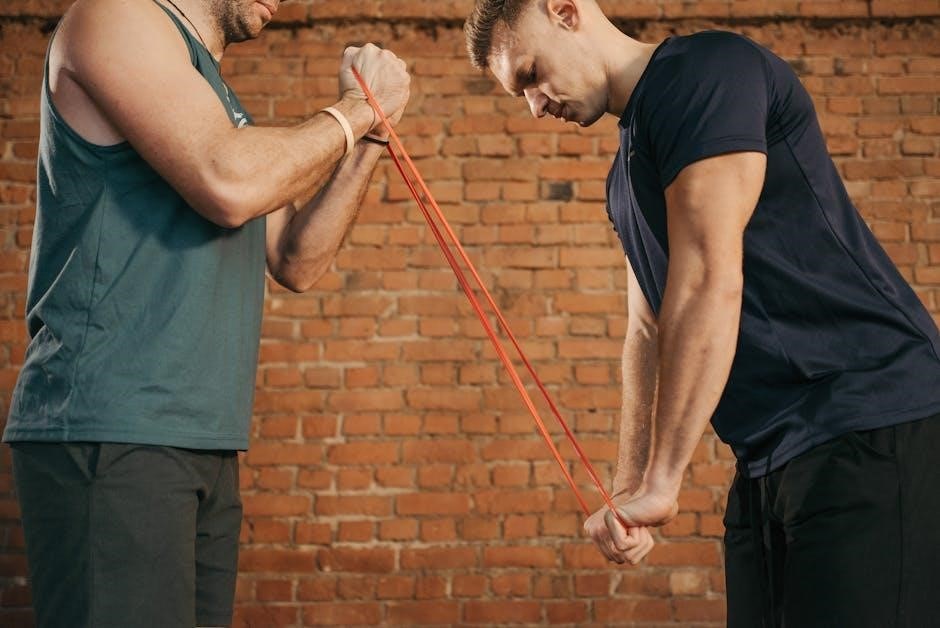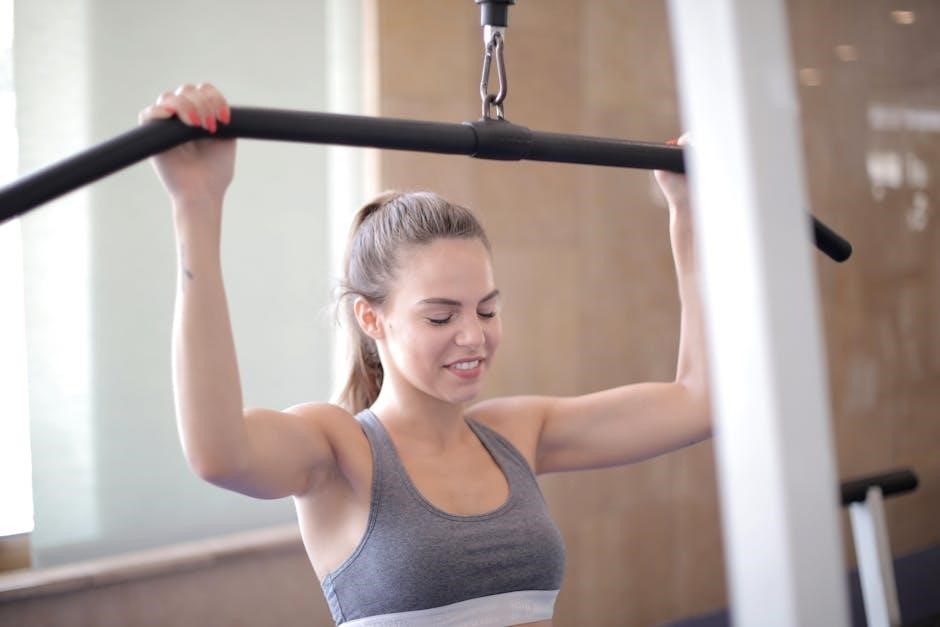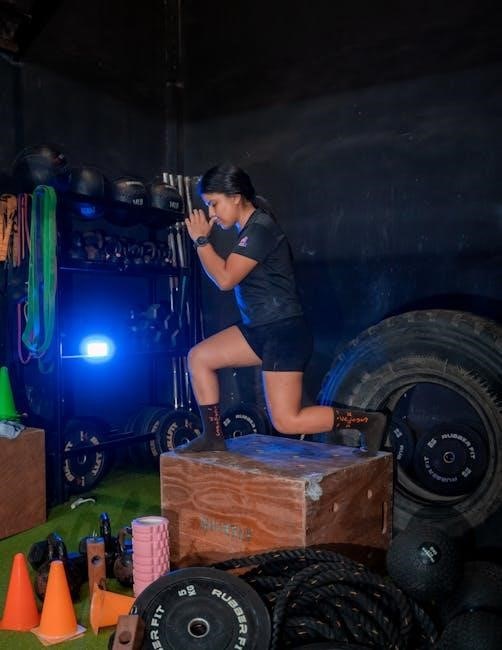Welcome to our comprehensive guide on upper body resistance band workouts! Discover how to strengthen your chest, shoulders, and triceps with portable, cost-effective exercises. Perfect for all fitness levels, these routines can be adjusted to challenge anyone, from beginners to advanced trainees. Explore effective techniques and progressions to maximize your upper body strength and achieve your fitness goals.
Benefits of Resistance Band Training
Resistance band training offers versatility, portability, and cost-effectiveness, making it ideal for upper body workouts. It provides variable resistance, enhancing strength and muscle engagement. Bands improve flexibility and joint mobility while being low-impact, reducing injury risks. They suit all fitness levels, allowing progression by adjusting tension or band thickness. Compact and lightweight, bands are perfect for home or travel use. They target multiple muscle groups simultaneously, saving time and promoting balanced development. Resistance bands also enhance functional strength, improving daily activities and sports performance. Their convenience and effectiveness make them a valuable tool for achieving upper body strength and fitness goals efficiently.
Overview of the Workout Structure
This upper body resistance band workout is designed to target key muscle groups, including the chest, shoulders, back, triceps, biceps, and core. The structure typically includes 3-4 sets of 12-16 repetitions for each exercise, with 45-60 seconds of rest between sets. Exercises are organized into circuits or supersets to maximize efficiency. Beginners start with lighter resistance, while advanced users can progress by increasing band tension or adding repetitions. The workout emphasizes proper form and controlled movements to ensure safety and effectiveness. This balanced approach ensures comprehensive upper body development, adaptable to any fitness level, and can be done anywhere with minimal equipment.

Choosing the Right Resistance Band
Select a resistance band based on your fitness level and goals, considering thickness, material, and portability for effective upper body workouts.
Types of Resistance Bands

Resistance bands come in various styles, including light, medium, and heavy-duty options. They are available in different materials, such as rubber, fabric, and latex, offering varying levels of durability and comfort. Some bands are looped, providing a secure grip, while others are straight, allowing for multiple anchoring points. Additionally, there are specialized bands designed for specific muscle groups, such as upper body or lower body workouts. Choosing the right type ensures an effective and safe exercise routine tailored to your fitness goals and preferences.
How to Select the appropriate resistance level
Selecting the right resistance level is crucial for an effective workout. Start with a lighter band to ensure proper form and control, especially for beginners. As your strength improves, progress to thicker bands offering greater resistance. Consider the muscle groups being targeted; for example, chest and shoulder exercises may require heavier bands than tricep or bicep workouts. Choose a resistance level that allows you to complete the recommended repetitions with proper form but still challenges your muscles. Adjust the band’s tension by shortening or lengthening it to suit your strength level and the specific exercise being performed. Always consult a professional for personalized guidance.

Safety Guidelines and Warm-Up
Always inspect the band for damage before use and start with lighter resistance. Maintain proper form to avoid injury. Begin with dynamic stretches like arm circles and shoulder rotations to prepare your muscles for the workout;
Pre-Workout Safety Tips
Inspect the resistance band for any signs of wear or damage before use. Start with a lighter resistance level and gradually increase as your strength improves. Avoid overstretching the band, as it may snap back and cause injury. Ensure proper form throughout each exercise to prevent muscle strain. Warm up with dynamic stretches, such as arm circles and shoulder rotations, to prepare your muscles. If you have any medical conditions, consult a therapist or trainer for personalized guidance. Always maintain control of the band during exercises to avoid accidental snaps. Prioritize proper breathing and avoid holding your breath during exertion.

Dynamic Stretching Routine
Begin with arm circles: Hold arms straight out to the sides and make small circles forward for 30 seconds, then backward for another 30 seconds. Next, perform shoulder rolls: Roll shoulders forward and backward in a circular motion for 1-2 minutes. Include torso twists: Stand tall, place hands on hips, and gently twist torso side to side for 30 seconds. Finish with chest opens: Hold a light resistance band behind your back and press arms backward to expand the chest, holding for 20-30 seconds; These exercises prepare your muscles for the workout, improving flexibility and reducing injury risk.

Chest Exercises with Resistance Bands
Strengthen your chest with resistance bands! Target pectoralis muscles effectively using versatile exercises like chest presses and incline variations to build strength and definition.
Band Chest Press
Perform the Band Chest Press by standing with feet shoulder-width apart, securing the band under one foot. Grip the band with both hands, keeping elbows slightly bent. Start in a slight squat, then press the band forward, extending your arms and squeezing your chest muscles. Aim for 10-12 repetitions, holding the press for 3 seconds. This exercise effectively targets the pectoralis muscles, improving chest strength and definition. Maintain tension throughout the movement for maximum effectiveness.
Incline Band Chest Press
Enhance your chest workout with the Incline Band Chest Press. Anchor the resistance band at shoulder height behind you. Sit on a stable surface with your back slightly inclined, holding the band ends in each hand. Press the band forward, extending your arms fully while squeezing your chest muscles. Hold for 3 seconds before slowly returning to the starting position. This exercise targets the upper chest muscles, promoting balanced development and improved posture. Aim for 10-12 repetitions, maintaining controlled movements to maximize engagement and minimize strain. Adjust the band’s resistance level to suit your fitness goals and strength level.

Shoulder and Triceps Exercises
Strengthen your shoulders and triceps with resistance band exercises. Target deltoids and triceps for improved posture, stability, and overall upper body definition. Perfect for all fitness levels.
Band Shoulder Press
Step into the resistance band with your feet shoulder-width apart, holding the band at shoulder height with palms facing forward. Engage your core, press the band overhead until your arms are fully extended. Avoid arching your back; keep your chest upright and maintain control throughout the movement. Slowly lower the band back to the starting position, taking 2-3 seconds to return. Perform 3 sets of 12-15 repetitions for optimal results. This exercise effectively targets the deltoids and triceps, improving shoulder strength and stability. Progress by increasing resistance when the exercise becomes manageable.
- Keep your core engaged for stability.
- Focus on controlled, deliberate movements.
- Progress by increasing resistance as needed.
Tricep Pushdowns with Resistance Bands
Attach the resistance band to a stable anchor above your head. Hold the band with both hands, elbows close to your body, and extend your arms fully, keeping your core engaged. Lower the band behind your head by bending your elbows, maintaining control throughout the movement. Extend your arms to return to the starting position, focusing on squeezing your triceps at the top. Perform 3 sets of 12-15 repetitions for optimal results. This exercise targets the triceps, enhancing arm strength and definition. Adjust the resistance level as needed to challenge your muscles effectively.
- Keep elbows close to your body to maintain proper form.
- Control the movement to avoid using momentum.
- Progress by increasing resistance or repetitions.

Back and Bicep Exercises
Target your back and biceps with effective resistance band exercises. Strengthen your posterior chain and arm muscles through controlled movements. Ideal for improving posture and overall upper body strength.
Seated Row with Resistance Band
Sit on the floor with your legs straight, looping the resistance band around your feet. Hold the band with both hands, keeping your arms extended. Engage your core, pull the band toward your chest, squeezing your shoulder blades together. Focus on controlled movements, avoiding rounded shoulders. Return to the starting position slowly. Aim for 10-12 repetitions per set. This exercise effectively targets the latissimus dorsi, trapezius, and biceps, improving posture and upper body strength. Maintain proper form throughout to maximize results and prevent strain.

Band Bicep Curl
Target your biceps with the Band Bicep Curl, an effective exercise for building upper body strength. Sit or stand with the resistance band looped under your feet, holding the ends in each hand. Keep your elbows close to your body and palms facing forward. Curl the band upward, squeezing your biceps at the top, then slowly lower it back to the starting position. Avoid using momentum and focus on controlled movements. Aim for 10-12 repetitions per set. This exercise isolates the biceps, promoting muscle growth and definition. Maintain proper form to prevent strain and maximize results.
Core and Stability Exercises
Strengthen your core and improve stability with resistance band exercises targeting abs, obliques, and lower back. Engage your muscles, enhance posture, and boost overall upper body strength effectively.
Band Russian Twists
Engage your core with the Band Russian Twist, a versatile exercise targeting the obliques and improving rotational strength. Sit on the floor with knees bent, feet lifted slightly, and the resistance band secured around your chest. Hold the band tightly, keeping elbows slightly bent. Twist your torso to one side, touching the band to the ground beside you, then twist to the opposite side. Maintain controlled movements, keeping your hips stable. Perform 10-12 repetitions on each side for 3 sets. This exercise enhances core stability, posture, and overall athletic performance. Progress by increasing resistance or repetitions as you build strength.
Resisted Plank Rows
Strengthen your back, shoulders, and core with the Resisted Plank Row; Loop the resistance band around a sturdy anchor or hold it under your hands in a plank position. Grip the band firmly, keeping your body straight and engaged. Pull one end of the band toward your chest, maintaining a stable core and avoiding any twisting. Hold for a brief moment, then slowly return to the starting position. Alternate sides for 10-12 repetitions per side, completing 3 sets. This exercise enhances posture, shoulder stability, and overall upper body strength. Progress by increasing resistance or repetitions as you build endurance.

Workout Structure and Progression
Begin with 3 sets of 10-12 reps for each exercise. Focus on controlled, deliberate movements. Gradually increase resistance, reps, or intensity as strength improves; Incorporate variations and circuit training for enhanced results.
Recommended Sets and Repetitions
Beginners should start with 1 set of 12-16 repetitions per exercise, focusing on proper form and progression. Intermediate to advanced trainees can perform 2-3 sets of 10-15 reps. Gradually increase resistance or reps as strength improves. For optimal results, maintain controlled movements and full range of motion. Rest for 30-60 seconds between sets to ensure muscle recovery and engagement. Adjust repetitions based on fitness goals, whether building endurance or strength. Consistency and progression are key to achieving desired outcomes in upper body resistance band workouts.
Progressing the Workout
To progress your upper body resistance band workout, increase resistance by using thicker bands or altering body positioning. Gradually raise the number of sets or repetitions as strength improves. Introduce more complex exercises or combine upper and lower body movements for a full-body challenge. As you advance, reduce rest periods between sets to enhance endurance. Incorporate variations like paused reps or slower tempos to increase intensity. Continuously challenge yourself to avoid plateaus and ensure steady progress in strength and muscle engagement. Adjustments should be gradual to maintain proper form and prevent injury, ensuring long-term success in your fitness journey.
Resistance band workouts are a versatile and effective way to build upper body strength. Consistency is key—aim to train 3-4 times per week for best results. Mix up your routine to keep it engaging and prevent plateaus. Focus on controlled movements to maximize muscle activation and minimize injury risk. Incorporate dynamic stretching before workouts and foam rolling after to enhance recovery. Track your progress by increasing resistance or reps over time. Stay hydrated, maintain a balanced diet, and ensure adequate rest to support muscle growth. With dedication, these exercises will help you achieve a stronger, more defined upper body and improved overall fitness.